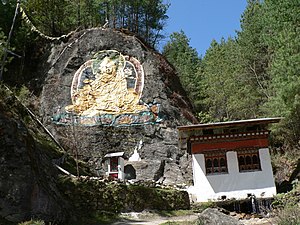
| Part of a series on the |
| Culture of Bhutan |
|---|
 |
| People |
| Languages |
| Cuisine |
| Religion |
| Art |
| Literature |
| Music |
| Sport |
Bhutanese art (Dzongkha: འབྲུག་པའི་སྒྱུ་རྩལ) is similar to Tibetan art. Both are based upon Vajrayana Buddhism and its pantheon of teachers and divine beings.
The major orders of Buddhism in Bhutan are the Drukpa Lineage and the Nyingma. The former is a branch of the Kagyu school and is known for paintings documenting the lineage of Buddhist masters and the 70 Je Khenpo (leaders of the Bhutanese monastic establishment). The Nyingma school is known for images of Padmasambhava ("Guru Rinpoche"), who is credited with introducing Buddhism into Bhutan in the 7th century. According to legend, Padmasambhava hid sacred treasures for future Buddhist masters, especially Pema Lingpa, to find. Tertöns are also frequent subjects of Nyingma art.
Each divine being is assigned special shapes, colors, and/or identifying objects, such as lotus, conch-shell, thunderbolt, and begging bowl. All sacred images are made to exact specifications that have remained remarkably unchanged for centuries.
Bhutanese art is particularly rich in bronzes of different kinds that are collectively known by the name Kham-so (made in Kham) even though they are made in Bhutan because the technique of making them was originally imported from that region of Tibet. Wall paintings and sculptures, in these regions, are formulated on the principal ageless ideals of Buddhist art forms. Even though their emphasis on detail is derived from Tibetan models, their origins can be discerned easily, despite the profusely embroidered garments and glittering ornaments with which these figures are lavishly covered. In the grotesque world of demons, the artists apparently had a greater freedom of action than when modeling images of divine beings.
The arts and crafts of Bhutan that represents the exclusive "spirit and identity of the Himalayan kingdom" is defined as the art of Zorig Chosum, which means the “thirteen arts and crafts of Bhutan”; the thirteen crafts are carpentry, painting, paper making, blacksmithery, weaving, sculpting and many other crafts. The Institute of Zorig Chosum in Thimphu is the premier institution of traditional arts and crafts set up by the Government of Bhutan with the sole objective of preserving the rich culture and tradition of Bhutan and training students in all traditional art forms; there is another similar institution in eastern Bhutan known as Trashi Yangtse. Bhutanese rural life is also displayed in the Folk Heritage Museum in Thimphu. There is also a Voluntary Artists Studio in Thimphu to encourage and promote the art forms among the youth of Thimphu. The thirteen arts and crafts of Bhutan and the institutions established in Thimphu to promote these art forms are:[1][2]
- ^ Brown, p. 104[incomplete short citation]
- ^ "Bhutan:Arts & Crafts". Tourism Council of Bhutan:Government of Bhutan. Archived from the original on 2010-06-12. Retrieved 2010-06-07.